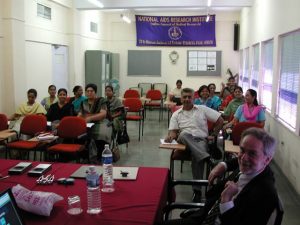Kevin Robertson has spent his career trying to understand the neurological effects of HIV to help patients live fuller lives, and this summer his work and leadership were recognized by the American Psychological Association.

Kevin Robertson has spent his career trying to understand the neurological effects of HIV to help patients live fuller lives, and this summer his work and leadership were recognized by the American Psychological Association.


By Caroline Curran
CHAPEL HILL, NC – Born in Salem, Virginia, but a true North Carolinian at heart, Kevin Robertson, PhD, is living his dream in his research role at UNC, where he is a professor of neurology and the director of the AIDS Neurological Center.
Robertson has led global research initiatives, and trained clinicians and researchers all over the world to establish research centers in Uganda, South Africa, Malawi, Nigeria, India, Thailand, Peru, and Zimbabwe. This summer, Robertson was recognized for his role in training the next generation of AIDS researchers across the globe by the American Psychological Association as the 2016 Distinguished Leader in Psychology and AIDS.
After earning a master’s degree from Western Carolina University and a doctorate from Oklahoma State University, Robertson came to UNC for a clinical internship in 1987 and he’s never even been tempted to leave.
“I could not have dreamed this up,” he said. “It’s so fulfilling. Any little thing you do in these places around the world and at home in North Carolina, it’s so appreciated, and then it goes so far. It’s just amazing. It really is.
“In my wildest dreams, I couldn’t have imagined becoming a professor at the University of North Carolina at Chapel Hill in the School of Medicine in neurology.
“When I was a kid, watching basketball with my dad in Wilmington and coming up here to Chapel Hill for basketball games, I just didn’t see any of this. I had no conception that this is where I would end up or that this would be the sort of work I’d be doing.”
In our most recent “Five Questions” feature series, we asked Robertson about his research on dementia and HIV, the early days of research at UNC, the unknowns of HIV, and collaboration at one of the top research universities in the world.
How did you break into such a specialized field of neurological and neuro-cognitive research on individuals infected with HIV?
I joined the faculty and did a post-doctoral fellowship here. As I was rolling off my clinical internship looking for a job, the vice-chair of neurology got a big grant to look at AIDS dementia. The neuropsychologist on the project needed someone to do neuropsychological assessments, and I was that someone.
I was looking to put things together to be able to stay here. I had done a lot of research on child abuse prior to that and was working with some of the people that were doing that work here at UNC. I initially had a half-time position with those folks – paid through psychiatry and then half-time with neurology, doing the HIV work. But within six months, we were hooked in at the national level – National Institutes of Health and the AIDS Clinical Trials Group – going up every few months to design clinical trials to look at the neurological and neuro-cognitive aspects of HIV and it just snowballed right away.
It was so compelling, so interesting, so cutting-edge and so much work needed to be done.
Where were scientists and researchers at that time – late 80s, early 90s – in terms of understanding the cognitive and neurological aspects of HIV infection?
It was in the very beginning. There had been a couple papers out there describing what they called AIDS dementia at the time, but none of the mechanisms were known. The prevalence and incidence weren’t known. We didn’t know what aspects of the nervous system were affected. It just wasn’t known. Was it just the central nervous system? Was it the peripheral nervous system? Autonomic nervous system? It turns out all of them are impacted.
We saw everything back then because, at the time, there was only AZT, the first antiretroviral drug. We designed the later trials to look at the first comparisons of the other drugs with AZT (for neuro-cognitive and neurologic outcomes) and then for two-drug trials and eventually the three-drug trials that were so successful in the mid-90s in treating HIV, suppressing it for a long time, and addressing a lot of the full-blown dementia that we saw.
When people came in to the clinic before that – if they had any cognitive symptoms, any early signs of dementia – there was often a rapid disease progression and they would die within six months.
I remember clearly Dr. Hall and I going up with a resident to do a dementia exam on an HIV-positive patient early on, before effective treatment. And the resident asked the patient simple orientation questions – what the patient’s name was, that kind of thing – and he gave 10 seconds or so before he moved on to the next question, and finally stopped. Then, after two questions or so of not responding, the patient finally said his name. It’s that profound kind of slowing [of the mind] that characterized the later stages of AIDS dementia and then later mutism and global impact on the brain, and they died. There was very little known. There weren’t any treatments, and there were all sorts of opportunistic infections that people got.
So, it wasn’t just the effects of the virus on the brain, but all of these other pathogens – toxoplasmosis, cryptococcal meningitis, progressive multifocal leukoencephalopathy – all of these things would occur among HIV-positive patients and they had just a massive amount of things attacking their brain.
UNC has been and continues to be a global leader in HIV and AIDS research. How has that collaborative atmosphere and established infrastructure influenced your research?
Even in 1987, there was a real interest in establishing an infrastructure here in infectious diseases and other disciplines. Things really took off when the Global HIV Prevention and Treatment Clinical Trials Unit was established to test the drugs that were in development and determine how effective they were.
Joe Eron led a number of those studies, and he’s just been a great collaborator and wonderful scientist and clinician and researcher. Mike Cohen has always been very supportive of my research in HIV in the brain. There’s always been really wonderful, collaborative, cutting-edge, leading scientists here at UNC doing this work. And it shows.
It shows in Mike Cohen’s work – showing that the virus can be suppressed and not transmitted to partners if you’re taking your antiretrovirals – and Ron Swanstrom’s work. Dr. Swanstrom, who’s head of the Center for AIDS Research, and I have had a long collaboration, as well, studying virus in the brain and comparing that to systemic virus and looking for compartmentalization.
What are the biggest misconceptions about HIV and AIDS – either in terms of people who are infected with the virus or in the actual virus itself?
I guess the first thing is that everybody thinks it’s somebody else’s problem. Truly. They think, “It can’t happen to me.” And I think that’s even more so now. There had been a lot of awareness, but I think people became complacent about HIV.
I don’t think people really know the extent of the neurological disease and the neuro-cognitive impact that HIV has. Certainly, we have made that relevant by conducting these studies to show people how prevalent it is.
On a more scientific level, I think the biggest misconception is that it’s a direct infection of neurons that causes the dementia.
Dementia is not due to direct infection of neurons. The virus doesn’t get into the neurons and kill them; it’s a sort of bystander effect. The virus is trafficked into the brain by infected cells. Through inflammatory processes and cytokine releases, we think this alters the function of neurons and can do so to the extent that the neuron dies.
But it’s not like you have AIDS dementia and it’s because, as you might think, there’s a direct infection of a neuron. It’s not that straight-forward.
We know that just suppressing the virus is not enough because there’s an ongoing inflammatory process that happens, even for people successfully treated with antiretroviral therapy. The milder impairments are more frequent than we thought. We were used to seeing this really devastating, full-blown dementia. Now what we see –with effective treatment – is a mild neurocognitive disorder, where people are suppressed, but they still have neurocognitive impairments and it’s due to the ongoing inflammatory process within the brain, even though we’re controlling most of the virus.
You can’t bring back the dead. If the neuron is dead, it’s not going to come back. But, there’s enough reason to think – from animal models from Rick Meeker’s lab and Victor Garcia’s lab –that there’s impairment of these neurons before they die.
In the mid-1990’s when Joe Eron was doing the clinical trials on triple therapy, I saw a patient who was mute. He was just shuffling around and his father had him by his arm to hold him up. He couldn’t say anything. We did what we usually did at that time. I did a cognitive assessment. Dr. Hall did a neurological assessment. Then we went out and spoke to the father and told him, ‘Look, in our experience, you should be prepared that your son won’t be with us that much longer.’
The patient was put on one of the first triple-drug regimens, and within three months he was talking again. Within six months he was arguing with his dad about being independent. So he had a rapid improvement in his dementia, but he never totally fully recovered. He still had a lot of frontal disinhibition, making poor judgements. He never came all the way back because, once you kill those neurons, they’re not going to come back. But we learned that you can recover some function of the neurons that were altered by the inflammatory response to the virus.
UNC is dedicating tremendous resources in the race for the cure – with the Cure Center, CFAR, AIDS Neurological Center, the Global HIV Prevention and Treatment Clinical Trials Unit. What’s the probability that the cure will be discovered in one of these many divisions in UNC?
I think if a cure is going to be found anywhere, it would be here, or maybe one or two other places. UNC is unique in having this Collaboratory of AIDS Researchers for Eradication that Dr. David Margolis runs with backing of pharma.
I’ve been focused on treatment, mostly. I think a cure is really important. My end of the cure would be looking at the brain. The brain is a protected environment and we know that there’s virus inside the central nervous system that’s protected by the blood-brain barrier, the blood-CSF barrier, and all of these controls that limit penetration of things from the outside, including antiretroviral medications.
When it comes to the strategies of shock and kill – latency reversal – where you reverse the quiescent [infected] cells and kill them with antiretrovirals, the brain is going to be really important. The brain is a protected compartment that we have to really look at if we want to completely rid someone of the virus.
But we’re just starting to really look at that. We will have to do more studies in that area – that is, how a curative therapy relates to eradication of virus within the brain.
Caroline Curran is a communications specialist at UNC Health Care and the UNC School of Medicine. She can be reached at caroline.curran@unchealth.unc.edu.